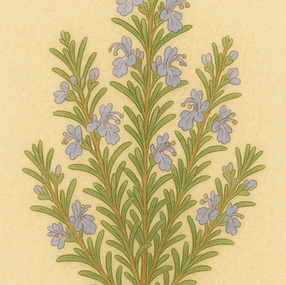
GROWING HERBS
Herbs are the kitchen’s quiet magicians—basil, oregano, chives, rosemary and their kin—each sprig carrying a spark of flavour that can turn the simplest dish into something extraordinary. A leaf here, a pinch there, and suddenly soups sing, stews deepen, casseroles comfort, and even puddings and cocktails dance with unexpected brightness.
But herbs have always been more than seasoning. For centuries, they’ve been gathered and brewed as healers’ companions—mint for settling the stomach, rosemary for remembrance, chamomile for calm. Even today, they whisper their way into remedies, carrying with them the wisdom of old gardens and wild hedgerows.
Most herbs are sun-seekers, happiest in a bright, sheltered spot where they can bask in the warmth. Grow them on your windowsill in small pots, cluster them in containers by the door, or let them stretch their roots freely in the garden soil—wherever they grow, they bring the fragrance of the green world straight into your kitchen.

HOW TO
Herbs are the heart-whisperers of the garden—some fleeting and quick, others steady companions that return year after year. Sow annuals like basil and coriander every few weeks, and you’ll have a never-ending summer supply of tender green leaves. Perennials such as oregano, rosemary, chives, and mint can be planted in pots or the earth itself, offering a faithful harvest whenever you wander by with your basket. Save the seed of the annuals as autumn closes in, but let the perennials sleep through winter, for they will awaken again with spring’s gentle touch.
Here are a few well-loved favourites from the herb garden’s lore:
-
Mint - Mint is the trickster of the garden—so generous, yet so quick to claim every corner it can. Best kept in its own pot, it comes in a rainbow of flavours: cooling spearmint, indulgent chocolate mint, even warming ginger mint. Snip it fresh for new potatoes, muddle it into sauces, or stir it into sparkling mojitos. A hardy perennial, mint is easily grown from root cuttings or young plants in spring or autumn. Plant it in moist but free-draining soil in gentle shade, and keep snipping to encourage fresh leafy growth. After flowering in late summer, cut plants back to soil level and feed, and they’ll reward you with a second flush before the frosts arrive.
-
Parsley - A humble kitchen staple with hidden strength, parsley is a biennial by nature but often treated as an annual. Best grown in partial shade, where it won’t rush into flower, parsley lends freshness to soups and stews. Rich in vitamin C and iron, it has long been praised as a breath-freshener and skin-cleanser. Sow seed every few weeks for a constant supply, grow in moist but well-drained soil, and gather leaves as needed. Curly or flat-leaf, both bring a bright green flourish to your table.
-
Thyme - Tiny but mighty, thyme is a herb of courage and warmth. Its delicate sprigs perfume roasted vegetables, soups, and even a gin glass. With lemon, orange, and many other varieties, thyme can tuck itself into paving cracks, gravel paths, or pots that can be brought indoors for winter. Grow in full sun, in light, well-drained soil. As an evergreen perennial, thyme can be harvested all year, though the best picking is in early summer, before it flowers. Cut back after flowering to keep it lively and shapely.
-
Rosemary - The ancient herb of remembrance, rosemary is strong, resinous, and evergreen. Pick sprigs throughout the year to stir into stews, sauces, or roast meats. Grow it in a sunny, sheltered site with well-drained soil, or in pots until the plants are well established. In heavy clay, mix in bark or grit to lighten the earth. Trim annually to prevent woodiness, mulch in autumn, and protect young plants from wet feet in winter. Harvest by plucking small sprigs or, for larger cuts, by snipping full branches.
-
Coriander - Known and loved across kitchens of the world, coriander is a herb of many gifts: tender leaves, fragrant stalks, and seeds with a golden, citrus aroma. Sow seed every few weeks from spring to autumn for a steady supply. Coriander grows best in moist but well-drained soil, with regular watering. Gather leaves as you need them, and let some plants run to seed if you’d like to save your own spice jars for winter.
-
Sage - Velvety and silver-green, sage brings depth to risottos, gnocchi, and pasta. A child of the Mediterranean, it craves full sun and free-draining soil. Perennial types are easiest grown from young plants, while annual and biennial sages can be started from seed. Many varieties thrive in pots, which suits their tidy growth. Harvest the leaves freely and trim after flowering to keep the plants bushy.
-
Tarragon - A touch of French elegance, tarragon carries the sweet note of anise and is indispensable in sauces. Mash the leaves into butter and spread over roasting chicken for a feast of flavour. French tarragon rarely produces seed, so it’s best grown from cuttings, root division, or young plants. Harvest often to encourage new leaves, and pinch away any buds that dare to form. Over winter, the top dies back, but fresh shoots will rise again in spring. It is tender at heart, so shelter it in colder months.



